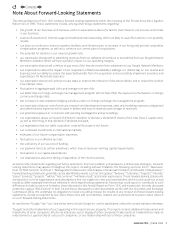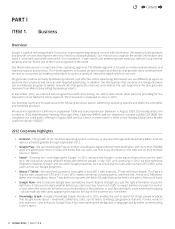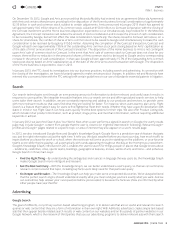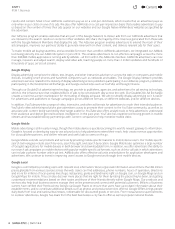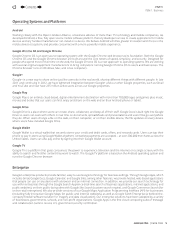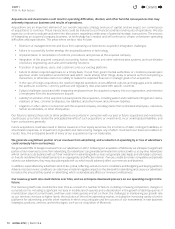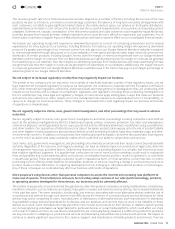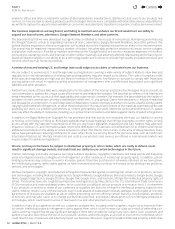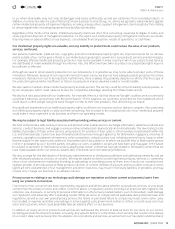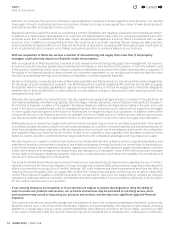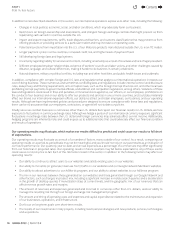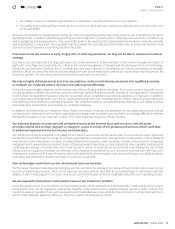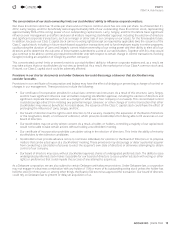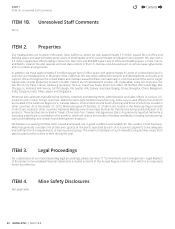Google 2012 Annual Report Download - page 16
Download and view the complete annual report
Please find page 16 of the 2012 Google annual report below. You can navigate through the pages in the report by either clicking on the pages listed below, or by using the keyword search tool below to find specific information within the annual report.
10 GOOGLE INC. | Form10-K
PART I
ITEM1A.Risk Factors
Acquisitions and investments could result in operating diffi culties, dilution, and other harmful consequences that may
adversely impact our business and results of operations.
Acquisitions are an important element of our overall corporate strategy and use of capital, and we expect our current pace
of acquisitions to continue. These transactions could be material to our fi nancial condition and results of operations. We also
expect to continue to evaluate and enter into discussions regarding a wide array of potential strategic transactions. The process
of integrating an acquired company, business, or technology has created, and will continue to create, unforeseen operating
di culties and expenditures. The areas where we face risks include:
•Diversion of management time and focus from operating our business to acquisition integration challenges.
•Failure to successfully further develop the acquired business or technology.
•Implementation or remediation of controls, procedures, and policies at the acquired company.
•
Integration of the acquired company’s accounting, human resource, and other administrative systems, and coordination
of product, engineering, and sales and marketing functions.
•Transition of operations, users, and customers onto our existing platforms.
•
Failure to obtain required approvals on a timely basis, if at all, from governmental authorities, or conditions placed upon
approval, under competition and antitrust laws which could, among other things, delay or prevent us from completing a
transaction, or otherwise restrict our ability to realize the expected fi nancial or strategic goals of an acquisition.
•
In the case of foreign acquisitions, the need to integrate operations across diff erent cultures and languages and to address
the particular economic, currency, political, and regulatory risks associated with specifi c countries.
•
Cultural challenges associated with integrating employees from the acquired company into our organization, and retention
of employees from the businesses we acquire.
•
Liability for activities of the acquired company before the acquisition, including patent and trademark infringement claims,
violations of laws, commercial disputes, tax liabilities, and other known and unknown liabilities.
•
Litigation or other claims in connection with the acquired company, including claims from terminated employees, customers,
former stockholders, or other third parties.
Our failure to address these risks or other problems encountered in connection with our past or future acquisitions and investments
could cause us to fail to realize the anticipated benefi ts of such acquisitions or investments, incur unanticipated liabilities, and
harm our business generally.
Future acquisitions could also result in dilutive issuances of our equity securities, the incurrence of debt, contingent liabilities, or
amortization expenses, or impairment of goodwill, and restructuring charges, any of which could harm our fi nancial condition or
results. Also, the anticipated benefi t of many of our acquisitions may not materialize.
We generate a signifi cant portion of our revenues from advertising, and a reduction in spending by or loss of advertisers
could seriously harm our business.
We generated 95% of Google revenues from our advertisers in 2012. Following our acquisition of Motorola, we still expect a signifi cant
portion of our revenues to come from advertising. Our advertisers can generally terminate their contracts with us at any time. Advertisers
will not continue to do business with us if their investment in advertising with us does not generate sales leads, and ultimately customers,
or if we do not deliver their advertisements in an appropriate and eff ective manner. If we are unable to remain competitive and provide
value to our advertisers, they may stop placing ads with us, which would adversely aff ect our revenues and business.
In addition, expenditures by advertisers tend to be cyclical, refl ecting overall economic conditions and budgeting and buying patterns.
Adverse macroeconomic conditions can also have a material negative impact on the demand for advertising and cause our advertisers
to reduce the amounts they spend on advertising, which could adversely aff ect our revenues and business.
Our revenue growth rate could decline over time, and we anticipate downward pressure onouroperating margin in the
future.
Our revenue growth rate could decline over time as a result of a number of factors, including increasing competition, changes in
our product mix, including a signifi cant increase in mobile search queries and a deceleration in the growth of desktop queries if
monetization stays at current levels, and how users make queries and act on them, the challenges in maintaining our growth rate
as our revenues increase to higher levels, the evolution of the online advertising market, including the increasing variety of online
platforms for advertising, and the other markets in which we participate and the success of our investments in new business
strategies, products, services, and technologies, such as our acquisition of Motorola.
Contents
44



